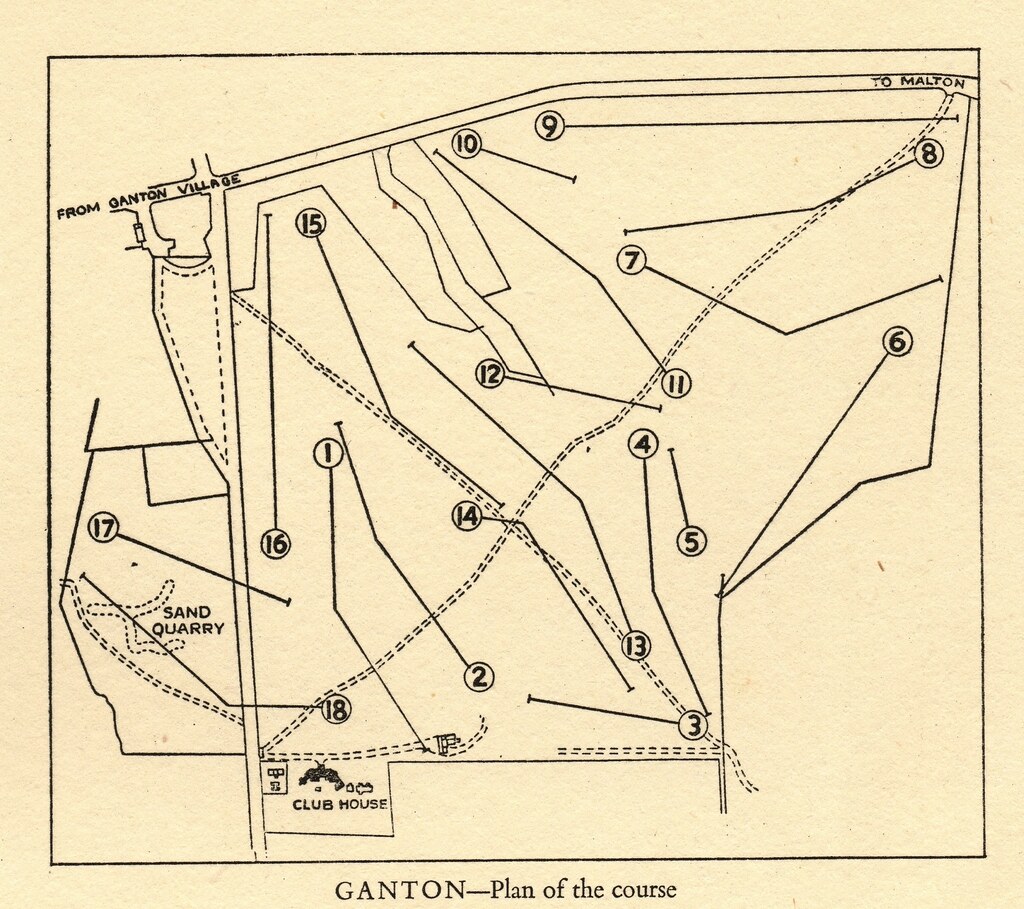Map of the course.

At once tucked away in England's no man’s land and yet perhaps the most heralded of all England’s inland courses, Ganton’s name lays on the tongue of the golf connoisseur with the same savoury taste as Yorkshire Pudding smothered in gravy. It wasn’t long after the founding of the club that Ganton began to build its reputation as a host of prominent events which is second to none among British inland courses. It was the unflappable Harry Vardon, the greatest of all English golfers, starring in the heyday of British domination of the game who took centre stage in two matches before the turn of the century could be counted. In 1895, a year before his appointment as club professional, Vardon comfortably dispatched with JH Taylor. The triumph propelled Vardon to win the first of a record six Open titles the following year at Murfield. Vardon scored another famous victory, this time over Willie Park Jr in 1899 by dismantling the Scottish professional over the final 36 hole leg of their challenge match. Not surprisingly, Vardon took the Claret Jug the same year at Sandwich by a cosy five shot margin.
It was the turn of the women for the next great event which saw Joyce Wethered emerge victorious in the 1923 English Ladies Championship. A further two English Ladies Championships and two English Amateur Championships were hosted previous to the epic 1949 Ryder Cup matches. Perhaps the matches were slightly marred by non-playing Captain Hogan’s claim that the grooves on some British clubs failed to comply with the rules. The R&A confirmed this suspicion and the club pro worked through the night to ensure the clubs adhered to rules. The US eventually won a closely fought contest 7-5. The Brabazon and PGA News of The World Matchplay (won by M Faulkner) soon followed. The impressive list of events continues to this day. Three Amateur Championships (Ganton being the only inland course to be so honoured), a Curtis Cup and most recently in 2003, a Walker Cup have all added to lore of Ganton.
Many well known writers have chipped in with their opinions. Patric Dickinson offered the following apt description: “Ganton doesn’t gamble. Play steadily, play discreetly, and play with good taste and common sense...it has no really quotable holes.” In one of the rare moments I would disagree with Bernard Darwin, no, Ganton isn't like Woking or Worplesdon. Ganton is rugged in a northern manner, yet one can’t say Ganton is overly long nor are there distressing carries. Where Ganton extracts its pound of flesh is in the relationship between the combination of strategic and penal bunkering and the subtle lay of the land. Of particular interest, and to beg off Dickinson once again, “...but there are other bunkers, beautiful sirens, daring us to steer too near them, rallying our faint hearts to carry over them, and sneering at our feebleness if we take the middle course.” There are several examples, but perhaps the best is displayed on the short two-shot third (which used to be a long par 3). There are also examples such as the second where a bunker(s) eats into the left of the fairway while the terrain leans right.
Unfortunately, when Ganton is in near perfect condition, running keen, the fairways can play quite narrow. At times it will take a near perfect tee shot to play the champion game. Of course, some will say Ganton is a championship links (there can be no better way to describe the course) and should therefore be punishing. Perhaps there is something in this attitude, but it is this author’s opinion that an extra 10 yards of width would truly make some of the more interestingly placed bunkers “beautiful sirens”.
The opener sets the tone. A tight drive which offers the scope of playing shy of the bunkers; in a nutshell, this is the Ganton dilemma. Below is our first look at a pit of despair.

Whereas the modest length first turns right, the more forceful second turns left. The front to back sloping green has a curious effect of creating a double dogleg. Many drives will finish out to the right and leave a less than envious angle of approach.

More to follow.
Ciao